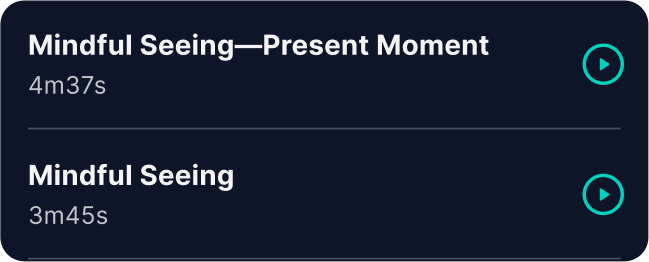Meditation for Children
by Annaka Harris
Annual - billed at $119.99 USD/yr
14 Day Free Trial
After the free trial, the subscription renews annually at $119.99 USD. Cancel anytime. Already a subscriber? Click here



A note from Annaka
Welcome to my guided meditations for children. All my recordings are designed for children ages six to ten, but the instructions are the same I would give to older children, teens, and beginner-level adults, so these recordings can be used by them as well.
Before you share the guided meditations on this app with children, please review the information below or listen to my recorded introduction.
I hope you and your children enjoy them!
Instructions and Recommendations




Listen with your child
It’s important for children (especially children under the age of nine) to listen to a new guided meditation with an adult, at least the first few times. I also recommend following each meditation session with some simple questions: How did you feel when we were doing that meditation? What part did you like best? Is there anything you didn’t like about it? Continue to ask questions like these each time to get a sense of how your child is responding to the practice.
If the meditations resonate with your child or your students, they can use them on their own after they’ve become comfortable doing them with you. After some time, children may also choose to practice meditation without the recordings. If they continue to practice on their own—with or without the guided meditations—I recommend that you still continue to check in with them, asking questions about how it’s going and what their experience is like.

Use speakers, not headphones
We are helping children learn to be present in their environment, and headphones can cause them to feel closed off from their surroundings, so it’s preferable that they listen through a speaker. However, there are definitely exceptions to this—especially in situations with a lot of distractions—and you’ll need to be the judge of whether headphones are a better choice.

Meditating with eyes open is okay!
Children should never be pressured into closing their eyes if they’re not comfortable doing so. Many people have a preconceived idea that our eyes should be closed when we meditate, but in all my recorded meditations, I give the option of eyes open or closed. Neither one is necessarily more effective, and this is true for both children and adults (in my own practice, I meditate with my eyes open about half the time). Our experiences can be different with eyes closed versus open, so it’s great if children feel comfortable trying both.

Meditation should not be mandatory
Meditation practice cannot be treated like homework or music practice, for two important reasons. First, it’s an entirely internal experience and exercise, so children need to be self-motivated and interested if they are to be successful. Second, requiring that a child practice meditation is essentially useless, because you can’t control someone else’s internal life—nor can you have direct evidence of it. Children can sit quietly for five minutes without meditating at all, and you won’t necessarily know what type of experience they are having. The best you can do is offer circumstances in which a child can discover the benefits from experience. It’s extremely important that children’s interest lead them and guide the amount of time they spend practicing meditation. They may want to practice one day and not the next, or they may lose interest for weeks or months at a time. As difficult as this may be for parents, my strong recommendation is that you offer your support and gently suggest that they try meditation but never require them to do so, especially when you encounter resistance.

Mindfulness is not about calming down
Although meditation often does calm us (and we often want children to calm down!), it’s important to remember that the goal of mindfulness meditation is simply to be aware of whatever one is feeling in the present moment. We want to provide the “space” for children to feel restless, anxious, or excited—and to become aware of their feelings. Paradoxically, recognizing and accepting uncomfortable feelings usually results in greater calm. But trying to calm down is not the point, and it can actually cause anxiety and be counterproductive. The intention should be to accept the present moment as it is, including uncomfortable feelings. The ultimate goal is to learn to identify feelings and tolerate them without judgment. When children feel restless, for example, we hope they can respond by thinking something like: It’s really hard to sit still right now, and that’s OK. Everyone feels this way sometimes. I can become curious about how I feel, take a breath, notice the energy and sensations in my body, listen to sounds, and be OK.

Your practice comes first
In the long term, I believe the most important thing you can do to maintain a child’s interest in meditation is to model it. I recommend letting your children witness, or at least be aware of, your regular practice. From time to time, talk about how meditation benefits you or what you find interesting about it—especially when it’s relevant to something that comes up in your lives. You can also try meditating for a few minutes in a room where your children are engaged in another activity. Set a timer and let them know that you’re going to sit and meditate for five minutes while they play or read. Every once in a while, they might surprise you by asking questions about what you’re doing—or even sit down and join you! But whether or not they do, seeing the adults in their lives practicing meditation has a great impact on children.
Tips and Variations







Mindful Hearing | Variations
In my classes, I sometimes use bells, drums, shakers, etc. to create sounds during a mindful hearing meditation. I didn’t include additional sounds in this recording because the element of surprise would be lost after only one use. But the fun of guessing the source of a wide range of sounds can also help children concentrate. You can ask them to count how many different sounds they hear, to try to guess the source of the sounds, or to pay attention to how their breathing changes (if it does) in response to different sounds. And it’s always fun for kids to take a turn making sounds for you!
Mindful Seeing | Tips
Before sitting down to listen to this meditation, you will need to find a small stone for children to use as their “focus rock.” You might make a fun outing of going on a walk to find a special rock.
Just like adults, children benefit from having a designated place to meditate, but this can be more difficult to create for a child. An object can work just as well (sometimes even better), and I love using focus rocks for this purpose. Having something that feels special, that is brought out only for meditation practice, and that reminds children of a state of mindfulness they can return to is extremely helpful. Encourage children to take care of their focus rocks and to keep them in special boxes or bags that they can decorate if they wish. Like a mantra, a focus rock often becomes a “home base” for children—one that’s portable!
See, Feel, Move, Breathe | Variations
If you’re doing this meditation as a group, you can try a fun variation: sit in a circle, and for bell #3, instead of placing the focus rocks back down in the same location, have everyone put their rock down in front of the person to their left. This way, each person has a new rock to look at for the next cycle. You can also try using other objects besides rocks—shells, flowers, and leaves are all nice-sized objects that are easy to find and work well for this activity. And when they’re ready to try this meditation without the recording, children can take turns leading the activity by ringing a bell or a chime.
Soothing Uncomfortable Feelings | Tips
This meditation focuses on the connection between emotions and sensations in the body and aims to relax areas of tension as a way of providing comfort for oneself. However, paying closer attention to difficult emotions or painful sensations in the body might intensify these feelings. When this is the case, many people find it helpful to instead pay attention to elements outside the body using a mindful seeing or hearing meditation. (Occasionally, a difficult life situation might even require a break from meditation practice altogether.) As always, it’s important to notice when practices are feeling counterproductive, without judging one’s reaction. The same meditation might help one person and not another, and similarly, it might have one effect at one time and another at a different time in the same person. We need to be especially nonjudgmental, open, and flexible with children (and ourselves) when experiencing uncomfortable feelings.
Note: The “clothing visualization” is my adaptation of an ideokinetic technique developed by Lulu E. Sweigard, “The Empty Suit.” (Lulu E. Sweigard, Human Movement Potential, Allegro Editions, 1974, P. 232.)
Nighttime Meditation | Tips
This meditation is designed to help children settle their bodies and minds at the end of the day. Parents can sit on the side of the bed as they listen with their child, or the whole family can gather in a room and spread out on the floor to meditate together. Nighttime Meditation with Friendly Wishes, is a slightly longer version and is designed for children who are having an especially hard time falling asleep. However, children may have a preference for one version or the other, regardless of how they’re feeling, so it’s a good idea to listen to both and let them decide which one they prefer.







Titles Guide

The titles of my guided meditations are straightforward, but some have two versions—titled short and long. Mindful Breathing, for example, has a short and a long version; the long one is simply intended for children who have had more experience and are ready for slightly longer periods of silence.
Titles Guide

Short and long versions
The titles of my guided meditations are straightforward, but some have two versions—titled short and long. Mindful Breathing, for example, has a short and a long version; the long one is simply intended for children who have had more experience and are ready for slightly longer periods of silence.

Additional concepts
Some meditations are presented in two versions because I introduce a concept or point out something helpful for children to be aware of. In those cases, I’ve added the concept to the title. For example, you’ll see a meditation titled Mindful Seeing and one titled Mindful Seeing—Present Moment. They are identical except that about halfway through the second one, I spend a little time discussing the concept of the present moment. Once children have heard this longer version a few times, they may prefer to listen to the short one so that they can simply do the practice.

Lessons
The audio lessons are intended for children who have had some practice and are interested in learning more about mindfulness meditation. Alternately, they can be used by parents and teachers as a guide for how to explain or talk to children about meditation.

Friendly Wishes*
The series of meditations titled Friendly Wishes is based on the traditional practice known as Metta or Loving Kindness meditation. In addition to being a concentration practice, these meditations help children develop compassion for themselves and others. For many children, sending friendly wishes has a relaxing effect and can be useful for settling down at bedtime.*A note about Friendly Wishes: Unfortunately, many children have someone in their life who is an unhealthy figure, and it’s important that this is taken into consideration when teaching children to meditate, especially when practicing Friendly Wishes. In my classes, I always assume that there is at least one child who has experienced trauma or has an unkind or abusive adult in their life, and my guided meditations are created with this sensitivity. But please pay attention to whether a child seems negatively affected by Friendly Wishes, and never ask a child to use this practice if it seems to make them uncomfortable. Lastly, we don’t ask children to send Friendly Wishes to a “difficult” person in their life—this is a practice that is only appropriate for adults. If children learn to cultivate compassion as a child, they will naturally move on to include more challenging people when they are old enough to understand the complicated nature of such relationships.

About Annaka

About Annaka
Annaka Harris is the New York Times bestselling author of CONSCIOUS: A Brief Guide to the Fundamental Mystery of the Mind and writer and producer of the audio documentary series, LIGHTS ON. Her work has appeared in The New York Times, Nautilus Magazine, the Journal of Consciousness Studies, and IAI Magazine. Annaka is also the author of the children’s book I Wonder and coauthor of the Mindful Games Activity Cards.
“As one of the very first to bring secular mindfulness into public schools, Annaka Harris is uniquely qualified to teach meditation to children in a simple, direct, and authentic way. I highly recommend Annaka’s guided meditations and lessons for children.”
—Susan Kaiser Greenland
author of Mindful Games and The Mindful Child
“These are my favorite guided meditations for kids!”
—Rivers Cuomo
musician and lead singer / songwriter of the band Weezer
“Annaka Harris brings decades of expertise to guide children in beautiful, playful, and engaging meditations to access kindness and awareness. She is one of the pioneers in the field of children’s mindfulness, and her accessible meditations are sure to delight children and parents alike.”
—Diana Winston
Director of Mindfulness Education at UCLA’s Mindful Awareness Research Center and author of The Little Book of Being
Additional Resources





